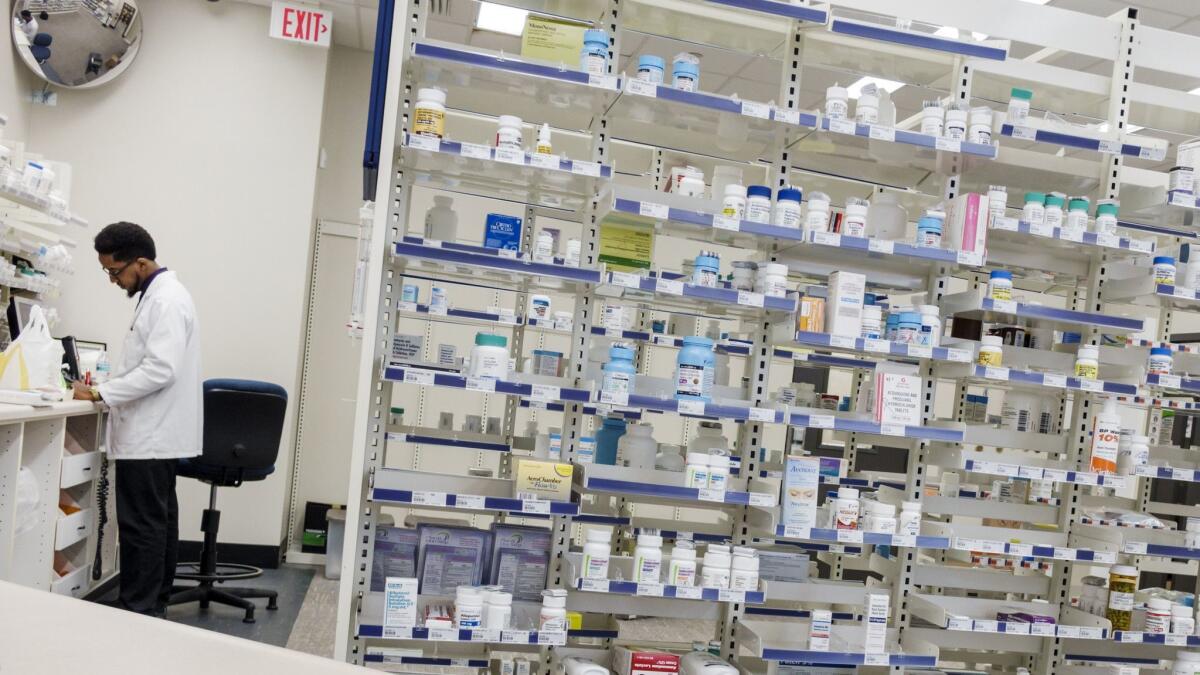Editorial: A drug with a multimillion-dollar price tag is making a mockery of Washington’s efforts to rein in prices

- Share via
Gilead Sciences, a California biopharmaceutical company, scored a major breakthrough in 2013 when the Food and Drug Administration approved Sovaldi, a pill that could cure hepatitis C when combined with another antiviral medication. And then Gilead delivered another breakthrough, albeit not a good one: It priced Sovaldi at $1,000 per pill, or $84,000 to $168,000 per course of treatment. The pricing stunned patients, insurers and state governments, which were suddenly exposed to billions of dollars in potential prescription costs.
But as it turns out, Sovaldi was just a milepost on the way to the six- and seven-figure prices that a new generation of specialty drugs are expected to command. These gene therapies seek to cure conditions linked to genetic abnormalities or alter cells to build up the body’s defenses. According to the pharmaceutical industry, close to 300 such treatments are in development, with the largest number of them focused on fighting cancer.
One of the first was Spark Therapeutics’ Luxturna, which the FDA approved in 2017. Luxturna, which can reverse blindness caused by a specific inherited condition, is a one-time treatment that costs $425,000 per eye. Next up is likely to be Novartis’ Zolgensma, a fix for the defective genes behind spinal muscular atrophy that the FDA could approve within weeks. No price has been set, but Novartis has said it is considering $1.5 million to $5 million for the treatment.
Market forces don’t function well in a field populated by monopoly suppliers, huge information gaps between providers and consumers, and life-or-death stakes.
Against this backdrop, the Trump administration and Congress have taken some first steps to address the problem of skyrocketing prescription drug costs. As welcome as all of these actions are, though, none of them would make an iota of difference in the price of Luxturna, Zolgensma or any other blockbuster drug with a blockbuster price tag.
That’s because they aim at easier targets, not daring to shorten the temporary patent monopoly that pharmaceutical companies are awarded over newly approved drugs, nor to tamper with the freedom those companies have to price their products even while they are shielded from competition.
Instead, the Trump administration has focused primarily on price transparency. This month, the Department of Health and Human Services finalized a rule requiring advertisements for many of the drugs covered by Medicare and Medicaid to disclose the medication’s list price. The idea is to stop patients from asking their doctors to prescribe drugs they don’t realize are prohibitively expensive, or costlier than equally effective alternatives.
That’s great — unless the drug in question happens to be the only drug that treats your condition. Market forces don’t function well in a field populated by monopoly suppliers, huge information gaps between providers and consumers, and life-or-death stakes.
The House, meanwhile, passed a healthcare bill that includes three prescription drug proposals with bipartisan backing. The three proposals — previously introduced as HR 1499, HR 965 and HR 938 — all would remove barriers to the introduction of generic drugs, which should help increase competition. But the competition they promote won’t arrive until after a drugmaker’s patents have expired, typically 12 or more years after a drug has been approved for sale.
Senate Democrats also are backing a proposal by Sen. Ron Wyden (D-Ore.) to cap the prescription drug costs faced by elderly Americans enrolled in Medicare Part D. That bill, which has some supporters in the pharmaceutical industry, wouldn’t cut into drug company revenues — it would simply shift drug costs from seniors with chronic or expensive conditions to taxpayers.
The ugly reality is that in many cases, the makers of medically necessary drugs can set prices as high as they wish. Breakthrough drugs, by definition, have no alternatives — a monopoly that’s then protected by federal patents. The only risk the manufacturers face is that insurers won’t cover the product or will discourage people from using it, which may not be a viable option for insurers if the drugs are truly effective.
Enter the Fray: First takes on the news of the minute »
Drugmakers, meanwhile, argue that they need to make enough profit off of successful new drugs to pay for all the research, false starts and failed trials that preceded them. Otherwise, they say, no one would make the risky investment in drug development. There’s some truth to that argument, but it also ignores the substantial investments that taxpayers make in the research that lights the way to new drug discoveries — and the enormous profits racked up by some drugmakers.
If Congress really wants to rein in the price of new branded drugs, it would need to take some pricing control away from the pharmaceutical industry.
The most popular proposal would be to let Medicare negotiate drug prices for the medications it covers, using the program’s enormous buying power to extract even larger discounts than the program now commands through statute. To be an effective negotiator, however, Medicare would have to be willing to drop coverage of some costly drugs, which would only expose the program to accusations of rationing.
So while that approach is worth considering, it is fraught with risk. The Trump administration has put forward an alternative — requiring drugmakers to sell their products to Medicare at the same price they do to European health insurance programs, which negotiate much lower prices than Medicare typically pays. The move could cut Medicare’s costs, but it would probably raise drug prices in Europe as well, blunting its effect here.
A third idea, advanced by John Rother of the National Coalition on Health Care, would be to have an independent body set prices for new drugs based on their effectiveness and some measure of affordability. That’s similar to what the Institute for Clinical and Economic Review does for a variety of healthcare products and services. The entire healthcare industry is trying to figure out how to base prices on the value of the care delivered, and Rother’s idea rides that wave.
But then, what’s the value of a treatment that cures a chronic disease? Surely it is more complicated than merely computing the cost of the care the patient will no longer need. How do you measure the value of a cure for blindness or a drug that eliminates years of pain and disability? If the new generation of breakthrough drugs are worth $1 million or more by those measures, then the issue won’t be how to rein in the drugs’ prices. It will be how to afford them.
Follow the Opinion section on Twitter @latimesopinionand Facebook
More to Read
A cure for the common opinion
Get thought-provoking perspectives with our weekly newsletter.
You may occasionally receive promotional content from the Los Angeles Times.










